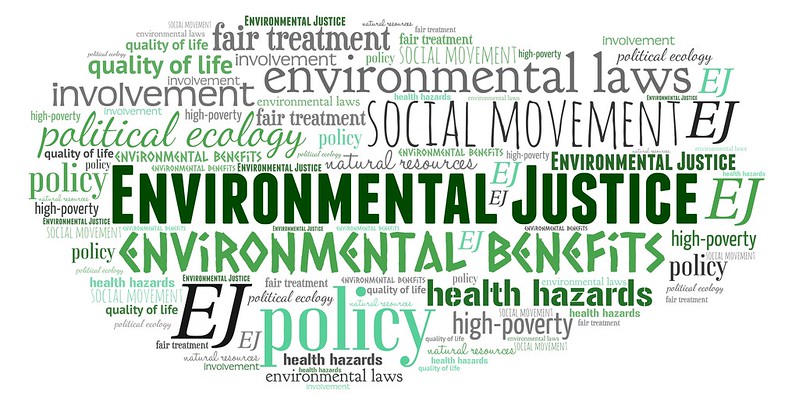What is Environmental Justice?
The idea is simple: No community should be forced to deal with more pollution because of their race, ethnicity, or socioeconomic status.

Image source
In reality, the United States has a long history of placing the environmental burden of hazardous waste sites, highways, industrial complexes, and other sources of pollution on communities of color and low-income neighborhoods. Consequently, these communities face inequitable and disproportionate exposure to toxic chemicals in the air they breathe, the water they drink and bathe in, and the soils they live on, play in, and use to grow food.
Just a glimpse at existing injustices show us that:
- 76% of the two million residents living within three miles of one of the 12 worst industrial plants are people of color.
- Three out of five Black people live in communities with uncontrolled toxic waste sites.
- Communities living below the poverty line have a 35% higher burden from particulate matter emissions than the overall population. Non-whites in general had a 28% higher health burden, while Black people, specifically, have a 54% higher burden than the overall population.
An Abbreviated History of the Environmental Justice Movement
In 1982, North Carolina announced they would be moving soil contaminated with PCBs from over 200 miles of its roadsides to a landfill in Warren County, one of the few counties in the state with a majority black population. Despite a series of major protests, the State’s plan carried on and the toxic material was buried. This was certainly not the first case of activism, but it was the first to gain national attention and is often considered the birth of the environmental justice movement.
A number of activist groups began popping up around the country throughout the 1980s to address ongoing environmental justice issues in their communities, like West Harlem Environmental Action (WE ACT) which worked to resolve poor management of the North River Sewage Treatment Plant, the construction of the sixth bus depot across from an intermediate school, and the development of a large housing complex just south of Westchester County.
In an attempt to address these communities’ concerns, the federal government under President George H. W. Bush created the Office of Environmental Justice within the Environmental Protection Agency in 1992. Two years later, President Bill Clinton signed an executive order that “direct[ed] federal agencies to identify and address the disproportionately high and adverse human health or environmental effects of their actions on minority and low-income populations, to the greatest extent practicable and permitted by law.” Despite another decade of promises, announcements, and policies from the capital, the injustices continued. In 2001, an EPA administrator released a statement stating:
“…environmental justice is the goal to be achieved for all communities and persons across this Nation. Environmental justice is achieved when everyone, regardless of race, culture or income, enjoys the same degree of protection from environmental and health hazards and equal access to the decision-making process to have a healthy environment in which to live, learn and work.”
While superficially agreeable, this statement has been criticized for refocusing environmental justice initiatives on the needs of “all” over the needs of specifically affected groups—a familiar tactic to silence oppressed voices.
Looking to the Future
Environmental and social justice are inextricably linked. From the Flint, Michigan water crisis in 2014 to the Dakota Access Pipeline tragedy in 2016, environmental burdens continue to fall on those communities who hold the least power to fight them. Addressing these inequities will only become more important as we face the impacts of climate change, exacerbating the need for clean water, air, and soil. But it won’t really be “we” – the most severe and imminent effects will undoubtedly fall on those same communities who are already suffering. So, it is our job as those in a place of privilege and power to become better environmental stewards by working against inequities in our communities to advance the progress of those before us.

About the Author
Nadya Hall, Community Environmentalist
Nadya has her master’s in environmental policy with a focus on human-wildlife coexistence. She is passionate about the conservation of wildlife and wild places through science, advocacy, and environmental education.

